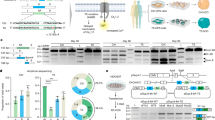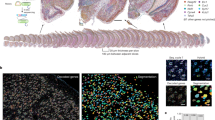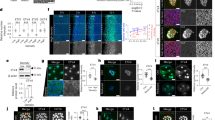Abstract
The development of neuronal networks in the neocortex depends on control mechanisms for mitosis and migration that allow newborn neurons to find their accurate position. Multiple mitogens, neurotrophic factors, guidance molecules and their corresponding receptors are involved in this process, but the mechanisms by which these signals are integrated are only poorly understood. We found that TrkB and TrkC, the receptors for brain-derived neurotrophic factor (BDNF) and neurotrophin-3 (NT-3), are activated by epidermal growth factor receptor (EGFR) signaling rather than by BDNF or NT-3 in embryonic mouse cortical precursor cells. This transactivation event regulated migration of early neuronal cells to their final position in the developing cortex. Transactivation by EGF led to membrane translocation of TrkB, promoting its signaling responsiveness. Our results provide genetic evidence that TrkB and TrkC activation in early cortical neurons do not depend on BDNF and NT-3, but instead on transactivation by EGFR signaling.
This is a preview of subscription content, access via your institution
Access options
Subscribe to this journal
Receive 12 print issues and online access
$209.00 per year
only $17.42 per issue
Buy this article
- Purchase on Springer Link
- Instant access to full article PDF
Prices may be subject to local taxes which are calculated during checkout






Similar content being viewed by others
References
Doetsch, F., Caille, I., Lim, D.A., Garcia-Verdugo, J.M. & Alvarez-Buylla, A. Subventricular zone astrocytes are neural stem cells in the adult mammalian brain. Cell 97, 703–716 (1999).
Götz, M. & Huttner, W.B. The cell biology of neurogenesis. Nat. Rev. Mol. Cell Biol. 6, 777–788 (2005).
Alvarez-Buylla, A., Garcia-Verdugo, J.M. & Tramontin, A.D. A unified hypothesis on the lineage of neural stem cells. Nat. Rev. Neurosci. 2, 287–293 (2001).
Gupta, A., Tsai, L.H. & Wynshaw-Boris, A. Life is a journey: a genetic look at neocortical development. Nat. Rev. Genet. 3, 342–355 (2002).
Angevine, J.B. & Sidman, R.L. Autoradiographic study of cell migration during histogenesis of cerebral cortex in the mouse. Nature 192, 766–768 (1961).
Rakic, P. Mode of cell migration to the superficial layers of fetal monkey neocortex. J. Comp. Neurol. 145, 61–83 (1972).
Molyneaux, B.J., Arlotta, P., Menezes, J.R.L. & Macklis, J.D. Neuronal subtype specification in the cerebral cortex. Nat. Rev. Neurosci. 8, 427–437 (2007).
Bayer, S.A. & Altman, J. Neocortical Development (Raven, New York, 1991).
Ayala, R., Shu, T. & Tsai, L.H. Trekking across the brain: the journey of neuronal migration. Cell 128, 29–43 (2007).
Rakic, P. Evolution of the neocortex: a perspective from developmental biology. Nat. Rev. Neurosci. 10, 724–735 (2009).
Maisonpierre, P.C. et al. NT-3, BDNF, and NGF in the developing rat nervous system: parallel as well as reciprocal patterns of expression. Neuron 5, 501–509 (1990).
Behar, T.N. Neurotrophins stimulate chemotaxis of embryonic cortical neurons. Eur. J. Neurosci. 9, 2561–2570 (1997).
Bartkowska, K., Paquin, A., Gauthier, A.S., Kaplan, D.R. & Miller, F.D. Trk signaling regulates neural precursor cell proliferation and differentiation during cortical development. Development 134, 4369–4380 (2007).
Ernfors, P., Lee, K.F. & Jaenisch, R. Mice lacking brain-derived neurotrophic factor develop with sensory deficits. Nature 368, 147–150 (1994).
Ernfors, P., Lee, K.-F., Kucera, J. & Jaenisch, R. Lack of neurotrophin-3 leads to deficiencies in the peripheral nervous system and loss of limb proprioceptive afferents. Cell 77, 503–512 (1994).
Medina, D.L. et al. TrkB regulates neocortex formation through the Shc/PLCgamma-mediated control of neuronal migration. EMBO J. 23, 3803–3814 (2004).
Lotto, R.B., Asavaritikrai, P., Vali, L. & Price, D.J. Target-derived neurotrophic factors regulate the death of developing forebrain neurons after a change in their trophic requirements. J. Neurosci. 21, 3904–3910 (2001).
Xu, B. et al. Cortical degeneration in the absence of neurotrophin signaling: dendritic retraction and neuronal loss after removal of the receptor TrkB. Neuron 26, 233–245 (2000).
Cheng, A., Wang, S., Cai, J., Rao, M.S. & Mattson, M.P. Nitric oxide acts in a positive feedback loop with BDNF to regulate neural progenitor cell proliferation and differentiation in the mammalian brain. Dev. Biol. 258, 319–333 (2003).
Visel, A. et al. Regulatory pathway analysis by high-throughput in situ hybridization. PLoS Genet. 3, 1867–1883 (2007).
Götz, R. et al. Bag1 is essential for differentiation and survival of hematopoietic and neuronal cells. Nat. Neurosci. 8, 1169–1178 (2005).
Lee, F.S., Ragagopal, R., Kim, A.H., Chang, P. & Chao, M.V. Activation of Trk neurotrophin receptor signaling by pituitary adenylate cyclase–activating polypeptides. J. Biol. Chem. 277, 9096–9102 (2002).
Wiese, S. et al. Adenosine receptor A2A-R contributes to motoneuron survival by transactivating the tyrosine kinase receptor TrkB. Proc. Natl. Acad. Sci. USA 104, 17210–17215 (2007).
Iwakura, Y., Nawa, H., Sora, I. & Chao, M.V. Dopamine D1 receptor–induced signaling through TrkB receptors in striatal neurons. J. Biol. Chem. 283, 15799–15806 (2008).
Caric, D. et al. EGFRs mediate chemotactic migration in the developing telencephalon. Development 128, 4203–4216 (2001).
Burrows, R.C., Wancio, D., Levitt, P. & Lillien, L. Response diversity and the timing of progenitor cell maturation are regulated by developmental changes in EGFR expression in the cortex. Neuron 19, 251–267 (1997).
Sun, Y., Goderie, S.K. & Temple, S. Asymmetric distribution of EGFR receptor during mitosis generates diverse CNS progenitor cells. Neuron 45, 873–886 (2005).
Rohrer, B., Korenbrot, J.I., LaVail, M.M., Reichardt, L.F. & Xu, B. Role of neurotrophin receptor TrkB in the maturation of rod photoreceptors and establishment of synaptic transmission to the inner retina. J. Neurosci. 19, 8919–8930 (1999).
Rajagopal, R. & Chao, M.V. A role for Fyn in Trk receptor transactivation by G protein–coupled receptor signaling. Mol. Cell Neurosci. 33, 36–46 (2006).
Lee, F.S. & Chao, M. Activation of Trk neurotrophin receptors in the absence of neurotrophins. Proc. Natl. Acad. Sci. USA 98, 3555–3560 (2001).
Mukhopadhyay, D. et al. Hypoxic induction of human vascular endothelial growth factor expression through c-Src activation. Nature 375, 577–581 (1995).
Resh, M.D. Fyn, a Src family tyrosine kinase. Int. J. Biochem. Cell Biol. 30, 1159–1162 (1998).
Fry, D.W. et al. A specific inhibitor of the epidermal growth factor receptor tyrosine kinase. Science 265, 1093–1095 (1994).
Vagin, O., Kraut, J.A. & Sachs, G. Role of N-glycosylation in trafficking of apical membrane proteins in epithelia. Am. J. Physiol. Renal Physiol. 296, F459–F469 (2009).
Gut, A. et al. Carbohydrate-mediated Golgi to cell surface transport and apical targeting of membrane proteins. EMBO J. 17, 1919–1929 (1998).
Vagin, O., Turdikulova, S. & Sachs, G. Recombinant addition of N-glycosylation sites to the basolateral Na,K-ATPase beta1 subunit results in its clustering in caveolae and apical sorting in HGT-1 cells. J. Biol. Chem. 280, 43159–43167 (2005).
Sibilia, M. & Wagner, E.F. Strain-dependent epithelial defects in mice lacking the EGF receptor. Science 269, 234–238 (1995).
Vielmetter, J., Stolze, B., Bonhoeffer, F. & Stuermer, C.A. In vitro assay to test differential substrate affinities of growing axons and migratory cells. Exp. Brain Res. 81, 283–287 (1990).
Knöll, B., Weinl, C., Nordheim, A. & Bonhoeffer, F. Stripe assay to examine axonal guidance and cell migration. Nat. Protoc. 2, 1216–1224 (2007).
Paves, H. & Saarma, M. Neurotrophins as in vitro growth cone guidance molecules for embryonic sensory neurons. Cell Tissue Res. 290, 285–297 (1997).
Ming, G.L. et al. Adaptation in the chemotactic guidance of nerve growth cones. Nature 417, 411–418 (2002).
Dontchev, V.D. & Letourneau, P. Nerve growth factor and semaphorin 3A signaling pathways interact in regulating sensory neuronal growth cone motility. J. Neurosci. 22, 6659–6669 (2002).
Rajagopal, R., Chen, Z.Y., Lee, F.S. & Chao, M.V. Transactivation of Trk neurotrophin receptors by G protein–coupled receptor ligands occurs on intracellular membranes. J. Neurosci. 24, 6650–6658 (2004).
Sibilia, M., Steinbach, J., Stingl, L., Aguzzi, A. & Wagner, E.F. A strain-independent postnatal neurodegeneration in mice lacking the EGF receptor. EMBO J. 17, 719–731 (1998).
Doetsch, F., Petreanu, L., Caille, I. & Garcia-Verdugo, J.M. & Alvarez-Buylla, A. EGF converts transit-amplifying neurogenic precursors in the adult brain into multipotent stem cells. Neuron 36, 1021–1034 (2002).
Tropepe, V., Craig, C.G., Morshead, C.M. & van der Kooy, D. Transforming Growth Factor-alpha Null and Senescent Mice Show Decreased Neural Progenitor Cell Proliferation in the Forebrain Subependyma. J. Neurosci. 17, 7850–7859 (1997).
Qiu, L. et al. Crosstalk between EGFR and TrkB enhances ovarian cancer cell migration and proliferation. Int. J. Oncol. 29, 1003–1011 (2006).
Meyer-Franke, A. et al. Depolarization and cAMP elevation rapidly recruit TrkB to the plasma membrane of CNS neurons. Neuron 21, 681–693 (1998).
Li, Y. et al. TrkB regulates hippocampal neurogenesis and governs sensitivity to antidepressive treatment. Neuron 59, 399–412 (2008).
Bergami, M. et al. Deletion of TrkB in adult progenitors alters newborn neuron integration into hippocampal circuits and increases anxiety-like behavior. Proc. Natl. Acad. Sci. USA 105, 15570–15575 (2008).
Arévalo, J.C. et al. Cell survival through Trk neurotrophin receptors is differentially regulated by ubiquitination. Neuron 50, 549–559 (2006).
Takahashi, H. et al. Postsynaptic TrkC and presynaptic PTPsigma function as a bidirectional excitatory synaptic organizing complex. Neuron 69, 287–303 (2011).
Rasmussen, R. Quantification on the LightCycler. in Rapid Cycle Real-Time PCR: Methods and Applications (ed. Meurer, S.) 21–34 (Springer, Berlin, 2001).
Jablonka, S., Beck, M., Lechner, B.D., Mayer, C. & Sendtner, M. Defective Ca2+ channel clustering in axon terminals disturbs excitability in motoneurons in spinal muscular atrophy. J. Cell Biol. 179, 139–149 (2007).
Acknowledgements
We would like to thank M. Sibilia (Medical University of Vienna) for providing Egfr−/− mice, Y.A. Barde (University of Basel ) for the HA-TrkB construct, K. Walter for excellent technical assistance, and W. Fouquet and S. Sigrist for their help in STED microscopy. This work was supported by the Deutsche Forschungsgemeinschaft, grants SFB 487, C4 (N.O.) and SFB 581, B4 (D.P. and M.S.), ForNeuroCell (M.S.) and by US National Institutes of Health grant NS21072-24 (M.V.C.).
Author information
Authors and Affiliations
Contributions
D.P. and M.S. designed the experiments. M.V.C. and T.H. provided tools and were involved in the early design of this study. D.P. performed most of the experiments. N.S. helped with the initial design and generation of lentiviruses for TrkB knockdown. T.H. generated viruses for dominant-negative Src. P.L. helped with biotin streptavidin cell surface protein isolation. N.O. helped with cell culture techniques for neural stem cells and performed the experiments. D.P. and M.S. wrote the manuscript.
Corresponding author
Ethics declarations
Competing interests
The authors declare no competing financial interests.
Supplementary information
Supplementary Text and Figures
Supplementary Figures 1–10 (PDF 2292 kb)
Rights and permissions
About this article
Cite this article
Puehringer, D., Orel, N., Lüningschrör, P. et al. EGF transactivation of Trk receptors regulates the migration of newborn cortical neurons. Nat Neurosci 16, 407–415 (2013). https://doi.org/10.1038/nn.3333
Received:
Accepted:
Published:
Issue Date:
DOI: https://doi.org/10.1038/nn.3333
This article is cited by
-
TrkB inhibition of DJ-1 degradation promotes the growth and maintenance of cancer stem cell characteristics in hepatocellular carcinoma
Cellular and Molecular Life Sciences (2023)
-
Reduced Cerebellar BDNF Availability Affects Postnatal Differentiation and Maturation of Granule Cells in a Mouse Model of Cholesterol Dyshomeostasis
Molecular Neurobiology (2023)
-
Dimeric mimetic of BDNF loop 4 promotes survival of serum-deprived cell through TrkB-dependent apoptosis suppression
Scientific Reports (2021)
-
Regulation of TrkB cell surface expression—a mechanism for modulation of neuronal responsiveness to brain-derived neurotrophic factor
Cell and Tissue Research (2020)
-
BDNF signaling during the lifetime of dendritic spines
Cell and Tissue Research (2020)



